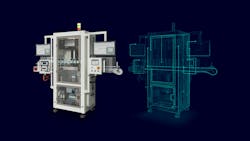Digital twins provide insights during machine design and validation processes
A Control Design reader writes: We recently helped a manufacturer set up a digital twin after the commissioning process on a new line in order for them to continually improve production. I clearly see the value of digital twin’s use of real-time data for our end users to improve operations. But what could be gained from the use of digital twins for system integrators during the design process or during commissioning to validate our designs and tweak layouts? Can digital twins be used to validate machine code or tune control parameters ahead of commissioning? Can or should one digital twin follow the lifecycle of the project from us to end user? Or do we need one digital twin for planning and design and a separate one for operations? We also became overwhelmed by the different formats for digital twins. How do we decide if we need a fully visualized platform or something simpler?
Answer
A single source of truth
System integrators can gain numerous benefits from using a digital twin during the design process or during commissioning to validate designs and tweak layouts. A comprehensive digital twin, backed by a robust product lifecycle management (PLM) system, allows a design team to manage the configuration and ensure that design, verification and manufacturing solutions are in sync. That is because a comprehensive digital twin is the single source of truth that optimizes and validates a design through virtual testing of the product before physically building it. A digital twin offers the ability to identify and address changes earlier in the design process and modify the design during virtual validation. Any changes identified during virtual validation can be made in a cost-effective manner during this stage. It is critical to validate the performance of the production process before building any hardware or investing in facilities, tooling and machines.
Can or should one digital twin follow the lifecycle of the product from designer to end user, or do you need separate ones for design and operations? It is essential to have a single comprehensive digital twin that matures through the lifecycle of the product as the production process is inherently linked to the design of the product. A single digital twin allows designers to improve decision-making early in the design process. As the design matures, the digital twin is maturing and enables designers to optimize the design of the products or production processes. Once the physical product is built, it is easier to understand its operation using the digital twin that has matured during the design cycle.
As far as the different formats for digital twins and how to decide between a fully visualized platform or something simpler, it is important to consider your business objective and what you are trying to achieve. If you are working greenfield, it is a different answer than working brownfield. No matter what is being designed, the digital twin consists of computer-aided design (CAD) geometry analysis, simulation models, bill of materials, requirements and all of the information that is required to define the product and the operation, characteristics and behavior of the product. You will need to be able to bring all of the data together and visualize and work with it in a way that is meaningful, and you can only do this with an open PLM solution. An open system allows you to bring in data from any CAD system and bring it together smoothly and easily in a single digital mockup.
Dale Tutt, vice president of industry strategy / Siemens Digital Industries Software
About the Author
Anna Townshend
Managing Editor
Anna Townshend has been a writer and journalist for 20 years. Previously, she was the editor of Marina Dock Age and International Dredging Review, until she joined Endeavor Business Media in June 2020. She is the managing editor of Control Design and Plant Services.

Leaders relevant to this article:

